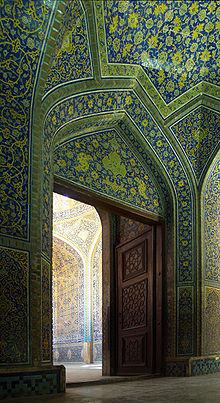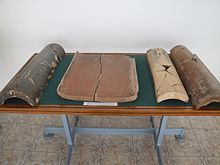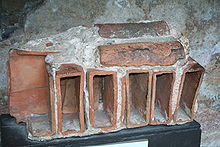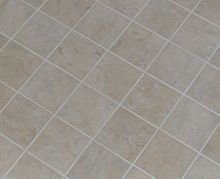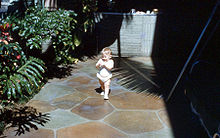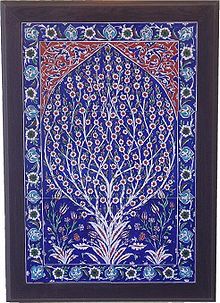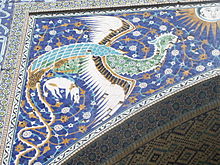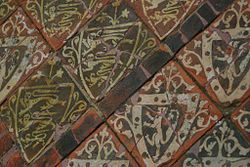- Tile
-
For other uses, see Tile (disambiguation).
A tile is a manufactured piece of hard-wearing material such as ceramic, stone, metal, or even glass. Tiles are generally used for covering roofs, floors, walls, showers, or other objects such as tabletops. Alternatively, tile can sometimes refer to similar units made from lightweight materials such as perlite, wood, and mineral wool, typically used for wall and ceiling applications. Less precisely, the modern term can refer to any sort of construction tile or similar object, such as rectangular counters used in playing games (see tile-based game). The word is derived from the French word tuile, which is, in turn, from the Latin word tegula, meaning a roof tile composed of fired clay.
Tiles are often used to form wall and floor coverings, and can range from simple square tiles to complex mosaics. Tiles are most often made from porcelain, fired clay or ceramic with a hard glaze, but other materials are also commonly used, such as glass, metal, cork, and stone. Tiling stone is typically marble, onyx, granite or slate. Thinner tiles can be used on walls than on floors, which require thicker, more durable surfaces.
Contents
Ceramic tiles
Earthenware
Ceramic with a water absorption rate of more than 10% after firing it at temperatures between 950 - 1150°C is known as earthenware. Earthenware is easy to work and easy to decorate. Because it is so porous though, it should only be used indoors to prevent weathering caused by frost. Earthenware is mainly used as glazed wall tiles.
Two different procedures for manufacturing earthenware can be distinguished: In the monoporasa technology, i.e. single firing technology, the liquid glaze is applied onto the tile immediately after shaping. Then the desired decoration can be applied onto the tile. In the double firing technology (biporosa) the body is fired first. Afterwards it is glazed, decorated and then fired again.
Stoneware
Stoneware has a water absorption rate of less than 3%. Stoneware is frost proof due to its low porosity. Compared to earthenware, stoneware has a higher density and a better mechanical strength. Almost all tiles for floor coverings exposed to high traffic such as for industry, commerce or public areas are made of unglazed stoneware that can be seen, for instance, at Nuremberg Central Station. Stoneware tiles with glaze are classical ceramics for floors. Abrasion and slip resistance are determined by the technical properties of the glaze.
Unlike earthenware, stoneware is fired at temperatures between 1150 - 1300°C. Porosity can be reduced by adding fluorite and other fluxes.
Porcelain stoneware
Porcelain stoneware is characterised by its very low water absorption rate of less than 0.5%. Thus porcelain stoneware is a further development of stoneware tiles, whose water absorption rate lies under 3%. Porcelain stoneware is manufactured under high pressure by dry-pressing fine processed ceramic raw materials with large proportions of quartz, feldspar and other fluxes. Afterwards, the body is baked at high temperatures (1200 - 1300°C) in a roller passage kiln.
Due to its high breaking and wear resistance properties porcelain stoneware is often used in public areas and areas where wear conditions are particularly extreme.
At the beginning of the development, porcelain stoneware was manufactured but unglazed.
The low porosity permits polishing a tile and thus creating an extraordinary beautiful and brilliant surface.
By applying ceramic powders of different colours or using soluble salts, unglazed porcelain stoneware can be decorated in different ways. However, the variety of possible visual effects is limited. Thereforce it becomes more and more usual to manufacture glazed and imprinted porcelain stoneware. A huge variety of decors can be created due to the properties provided by this material. For instance, the most different types of stones, woods, fabrics, cork, leather etc. can be imitated.
Glazed porcelain stoneware differs from glazed stoneware by a slightly higher breaking resistance and a complete frost resistance. Other properties, such as, for instance, chemical resistance, slip resistance and scratch hardness may vary significantly depending on the type of surface.
Cleaning, protection,care
Porcelain stoneware polished and matt
- Newly laid areas
Adherence of dirt on hardly visible remains of joint material or adhesives makes later maintenance cleaning difficult.Thus all floor coverings should be cleaned with a standard cement residue remover. Residues of joints containing plastic can be removed with an intensive cleaner.
- Preliminary cleaning in case of protective treatment of used and soiled tiles
Treatment of a used floor covering requires a thorough preliminary cleaning. All impurities and maintenance agents have to be removed from the surface and the pores. For this purpose, a commercially available intensive cleaner should be used under observance of the instructions for use.
- Protective treatment against stains
Depending on the type of use of the floor covering, stains may appear despite the exceptional properties of porcelain stoneware tiles. A single treatment with a standard protective impregnation reduces delicateness and increases ease of care. Ingress of dirt, oil, grease, wax, paint etc. can be significantly reduced, so that hardly any stains appear or stains can be easily removed. This treatment is recommended for newly laid floor coverings with a polished surface. Whether or not this treatment is suitable for structured or matt surfaces has to be checked. In most cases an impregnation of very light or dark coloured floor coverings is effective.
Some manufactureres offer factory-sealed matt ( currently even polished ) porcelain stoneware tiles.
- Regular maintenance care
Adding a standard maintenance and cleaning agent to the floor-cleaning water is recommended for regular maintenance care.
- Additional maintenance care
From time to time floor coverings, where wear conditions are particularly extreme, require a basic cleaning. For this purpose, it is recommended to add an intensive cleaner to the cold or lukewarm floor-cleaning water. In case of lime scale or spots of rust, a sanitary cleaning agent should be used.
Glazed tiles
Glazed tiles are available in many different colors and dimensions. Basically, two types can be distinguished:
Wall tiles, which in technical language are called stoneware tiles, and floor tiles, which may be manufactured from stoneware or porcelain stoneware. What they all have in common is a glazed, closed surface,which is very durable and easy to clean. Some instructions for care of these coverings:
- First cleaning of new areas
In case of remains of grout on the surface, the covering should be wiped once with a standard sanitary cleaning agent under observance of the manufacturer´s instructions for use.
- Cleaning of heavily soiled areas
Persistent dirt, remains of caring products, oily and greasy residues etc. can be easily removed with a basic cleaning agent. It is recommended to clean sanitary areas such as bathrooms, showers, toilets with a sanitary cleaning agent to avoid lime scale and to dispose of incrustations.
- Protection and care
Glazed tiles can be impregnated but don´t have to and they don´t have to be protected in another way. Products containing wax and acrylic are not suitable as they may form layers. These layers bind soil and make maintenance cleaning more difficult. Cement joints are porous and soil easily. By impregnating them with a joint protection, soiling can be reduced and cleaning will be easier.
Please note: Always follow the manufacturer´s instructions of use.'
Environmental aspects
Ceramic tiles do not contain substances harmful to health. The air of rooms is in no way influenced by hydraulic tile adhesive and grout during workmanship and so a pleasant room atmosphere is created guaranteeing healthy living.
Ceramic tiles have a closed surface fired at high temperatures. Allergenic substances such as mites and house dust can hardly settle or develop on such surfaces.
With appropriate ventilation, ceramic coverings prevent formation of mould in rooms with high humidity such as bathrooms, kitchens and toilets.
Ceramic tiles are odourless and they neither absorb nor store odours, vapours or smoke.
Ceramic tiles are particularly suitable for underfloor heatings due to their ability to store and conduct heat. The even heat distribution saves heating costs and owing to a low air circulation, less dust is risen. As a result, the air in the room is less polluted by circulating dust.
Roof tiles
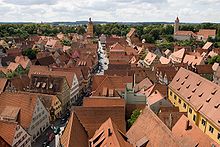 Roofs with "beaver tail" tiles in Dinkelsbühl, Germany.
Roofs with "beaver tail" tiles in Dinkelsbühl, Germany.
Roof tiles are designed mainly to keep out rain, and are traditionally made from locally available materials such as clay or slate. Modern materials such as concrete and plastic are also used and some clay tiles have a waterproof glaze. A large number of shapes (or "profiles") of roof tiles have evolved. These include:
- Flat tiles - the simplest type, which are laid in regular overlapping rows. An example of this is the clay-made "beaver-tail" tile (German Biberschwanz), common in Southern Germany. Flat roof tiles are usually made of clay but also may be made of stone, wood, plastic, concrete, or solar cells.
- Imbrex and tegula, an ancient Roman pattern of curved and flat tiles that make rain channels on a roof.
- Roman tiles - flat in the middle, with a concave curve at one end at a convex curve at the other, to allow interlocking.
- Pantiles - with an S-shaped profile, allowing adjacent tiles to interlock. These result in a ridged pattern resembling a ploughed field. An example of this is the "double Roman" tile, dating from the late 19th century in England and USA.
- Mission or barrel tiles are semi-cylindrical tiles laid in alternating columns of convex and concave tiles. Originally they were made by forming clay around a curved surface, often a log or the maker's thigh. Today barrel tiles are mass produced from clay, metal, concrete or plastic.
- Interlocking roof tiles are similar to pantile with side and top locking to improve protection from water and wind.
Roof tiles are 'hung' from the framework of a roof by fixing them with nails. The tiles are usually hung in parallel rows, with each row overlapping the row below it to exclude rainwater and to cover the nails that hold the row below. There are also roof tiles for special positions, particularly where the planes of the several pitches meet. They include ridge, hip and valley tiles.
Similarly to roof tiling, tiling has been used to provide a protective weather envelope to the sides of timber frame buildings. These are hung on laths nailed to wall timbers, with tiles specially moulded to cover corners and jambs. Often these tiles are shaped at the exposed end to give a decorative effect. Another form of this is the so-called mathematical tile, which was hung on laths, nailed and then grouted. This form of tiling gives an imitation of brickwork and was developed to give the appearance of brick, but avoided the Brick Taxes of the 18th century.[1]
History
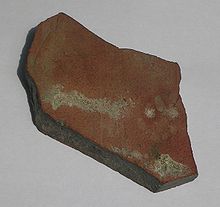 Roman roof tile fragment (78mm wide by 97mm high) found in York, UK, with the impression of a kitten's paw.
Roman roof tile fragment (78mm wide by 97mm high) found in York, UK, with the impression of a kitten's paw.
Fired roof tiles are found as early as the 3rd millennium BC in the Early Helladic House of the tiles in Lerna, Greece.[2][3] Debris found at the site contained thousands of terracotta tiles having fallen from the roof.[4] In the Mycenaean period, roofs tiles are documented for Gla and Midea.[5]
The earliest finds of roof tiles in archaic Greece are documented from a very restricted area around Corinth (Greece), where fired tiles began to replace thatched roofs at two temples of Apollo and Poseidon between 700-650 BC.[6] Spreading rapidly, roof tiles were within fifty years in evidence for a large number of sites around the Eastern Mediterranean, including Mainland Greece, Western Asia Minor, Southern and Central Italy.[7] Early roof tiles showed an S-shape, with the pan and cover tile forming one piece. They were rather bulky affairs, weighing around 30 kg apiece.[8] Being more expensive and labour-intensive to produce than thatch, their introduction has been explained by their greatly enhanced fire resistance which gave desired protection to the costly temples.[9]
The spread of the roof tile technique has to be viewed in connection with the simultaneous rise of monumental architecture in ancient Greece. Only the appearing stone walls, which were replacing the earlier mudbrick and wood walls, were strong enough to support the weight of a tiled roof.[10] As a side-effect, it has been assumed that the new stone and tile construction also ushered in the end of 'Chinese roof' (Knickdach) construction in Greek architecture, as they made the need for an extended roof as rain protection for the mudbrick walls obsolete.[11]
Production of dutch roof tiles started in the 14th century when city rulers required the use of fireproof materials. At the time most houses were made of wood and had thatch roofing, which would often cause fires to quickly spread. To satisfy demand, many small roof tile makers began to produce roof tiles by hand. Many of these small factories were built near rivers where there was a ready source of clay and cheap transport.
Floor tiles
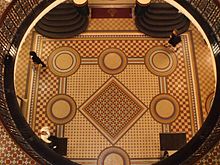 The elaborate floor pattern of the Sydney Queen Victoria Building
The elaborate floor pattern of the Sydney Queen Victoria Building
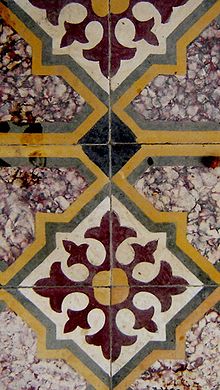 Floor tile in Karpas, northeastern Cyprus
Floor tile in Karpas, northeastern Cyprus
These are commonly made of ceramic or stone, although recent technological advances have resulted in rubber or glass tiles for floors as well. Ceramic tiles may be painted and glazed. Small mosaic tiles may be laid in various patterns. Floor tiles are typically set into mortar consisting of sand, cement and often a latex additive for extra adhesion. The spaces between the tiles are nowadays filled with sanded or unsanded floor grout, but traditionally mortar was used.
Natural stone tiles can be beautiful but as a natural product they are less uniform in color and pattern, and require more planning for use and installation. Mass produced stone tiles are uniform in width and length. Granite or marble tiles are sawn on both sides and then polished or finished on the facing up side, so that they have a uniform thickness. Other natural stone tiles such as slate are typically "riven" (split) on the facing up side so that the thickness of the tile varies slightly from one spot on the tile to another and from one tile to another. Variations in tile thickness can be handled by adjusting the amount of mortar under each part of the tile, by using wide grout lines that "ramp" between different thicknesses, or by using a cold chisel to knock off high spots.
Some stone tiles such as polished granite, marble, and travertine are very slippery when wet. Stone tiles with a riven (split) surface such as slate or with a sawn and then sandblasted or honed surface will be more slip resistant. Ceramic tiles for use in wet areas can be made more slip resistant either by using very small tiles so that the grout lines acts as grooves or by imprinting a contour pattern onto the face of the tile.
The hardness of natural stone tiles varies such that some of the softer stone (e.g. limestone) tiles are not suitable for very heavy traffic floor areas. On the other hand, ceramic tiles typically have a glazed upper surface and when that becomes scratched or pitted the floor looks worn, whereas the same amount of wear on natural stone tiles will not show, or will be less noticeable.
Natural stone tiles can be stained by spilled liquids; they must be sealed and periodically resealed with a sealant in contrast to ceramic tiles which only need their grout lines sealed. However, because of the complex, non repeating patterns in natural stone, small amounts of dirt on many natural stone floor tiles do not show.
Most vendors of stone tiles emphasize that there will be variation in color and pattern from one batch of tiles to another of the same description and variation within the same batch. Stone floor tiles tend to be heavier than ceramic tiles and somewhat more prone to breakage during shipment.
Rubber floor tiles have a variety of uses, both in residential and commercial settings. They are especially useful in situations where it is desired to have high-traction floors or protection for an easily breakable floor. Some common uses include flooring of garage, workshops, patios, swimming pool decks, sport courts, gyms, and dance floors.
Plastic floor tiles including interlocking floor tiles that can be installed without adhesive or glue are a recent innovation and are suitable for areas subject to heavy traffic, wet areas and floors that are subject to movement, damp or contamination from oil, grease or other substances that may prevent adhesion to the substrate. Common uses include old factory floors, garages, gyms and sports complexes, schools and shops.
Decorative tilework and coloured brick
Decorative tilework should be distinguished from mosaic, where forms are made of great numbers of tiny irregularly positioned tesserae in a single colour, usually of glass or sometimes ceramic.
The earliest evidence of glazed brick is the discovery of glazed bricks in the Elamite Temple at Chogha Zanbil, dated to the 13th century BCE. Glazed and coloured bricks were used to make low reliefs in Ancient Mesopotamia, most famously the Ishtar Gate of Babylon (ca. 575 BCE), now partly reconstructed in Berlin, with sections elsewhere. Mesopotamian craftsmen were imported for the palaces of the Persian Empire such as Persepolis.
Tiling was widespread in the time of the Sinhalese kings of ancient Sri Lanka, using smoothed and polished stone laid on floors and in swimming pools. Historians consider the techniques and tools for tiling as well advanced, evidenced by the fine workmanship and close fit of the tiles.[citation needed] Tiling from this period can be seen Ruwanwelisaya and Kuttam Pokuna in the city of Anuradhapura.
Islamic tiles
Early Islamic mosaics in Persia consist mainly of geometric decorations in mosques and mausoleums, made of glazed brick. Typical turquoise tiling becomes popular in 10th-11th century and is used mostly for Kufic inscriptions on mosque walls. Seyed Mosque in Isfahan (1122 AD), Dome of Maraqeh (1147 AD) and the Jame Mosque of Gonabad (1212 AD) are among the finest examples.[12] The dome of Jame' Atiq Mosque of Qazvin is also dated to this period.
The golden age of Persian tilework begins with under the Timurid Empire. Single color tiles were cut into small pieces and assembled by pouring liquid plaster between them. After hardening, these panels were assembled on the walls of buildings. But the mosaic was not limited to flat areas. Jame Mosque in Yazd (1324-1365 AD) and Goharshad Mosque (1418 AD) are prominent examples of brick and tile mosaics of interiors and external surfaces of domes.[12] Islamic buildings in Bukhara (16th-17th century) also exhibit very sophisticated floral ornaments.
Mihrabs, being focus points of mosques, were usually the places where most sophisticated tilework was placed. The 14th century mihrab at Madrasa Imami in Isfahan is an outstanding example of aesthetic union between the islamic calligrapher's art and abstract ornament. The pointed arch, framing the mihrab's niche, bears an inscription in Kufic script used in 9th-century Qur'an.[13]
One of the best known architectural masterpieces of Iran is the Shah Mosque in Isfahan, from the 17th century. Its dome is a prime example of tile mosaic and it's winter praying hall houses one of the finest ensembles of cuerda seca tiles in the world. Wide variety of tiles had to be manufactured in order to cover complex forms of the hall with consistent mosaic patterns. The result was a technological triumph as well as a dazzling display of abstract ornament.[13]
During the Safavid period mosaic ornaments vere often replaced by a haft rang (seven colors) technique. Pictures were painted on plain rectangle tiles, glazed and fired afterwards. Besides economic reasons, the seven colors method gave more freedom to artists and was less time-consuming. It was popular until Qajar period when the palette of colors was extended by yellow and orange.[12]
The Persianate tradition continued and spread to much of the Islamic world, notably the İznik pottery of Turkey under the Ottoman Empire in the 16th and 17th centuries. Palaces, public buildings, mosques and türbe mausoleums were heavily decorated with large brightly coloured patterns, typically with floral motifs, and friezes of astonishing complexity, including floral motifs and calligraphy as well as geometric patterns.
The zellige tradition of Arabic North Africa uses small coloured tiles of various shapes to make very complex geometric patterns. It is halfway to mosaic, but as the different shapes must be fitted precisely together, falls under tiling.
Western tilework
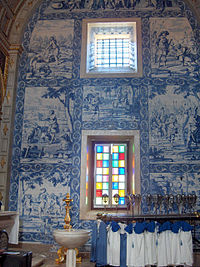 Azulejos by Willem van der Kloet (1708) in the transept of the Church of Nossa Senhora da Nazaré; Nazaré, Portugal
Azulejos by Willem van der Kloet (1708) in the transept of the Church of Nossa Senhora da Nazaré; Nazaré, Portugal
Medieval Europe made considerable use of painted tiles, sometimes producing very elaborate schemes, of which few have survived. Religious and secular stories were depicted. The imaginary tiles with Old testament scenes shown on the floor in Jan van Eyck's 1434 Annunciation in Washington are an example. The 14th century "Tring tiles" in the British Museum show childhood scenes from the Life of Christ, possibly for a wall rather than a floor,[14] while their 13th century "Chertsey Tiles", though from an abbey, show scenes of Richard the Lionheart battling with Saladin in very high-quality work.[15] Medieval letter tiles were used to create Christian inscriptions on church floors.
Transmitted via Islamic Spain, a new tradition of azulejos developed in Spain and especially Portugal, which by the Baroque period produced extremely large painted scenes on tiles, usually in blue and white, for walls rather than floors. Delftware wall tiles, typically with a painted design covering only one (rather small) blue and white tile, were ubiquitous in Holland and widely exported over Northern Europe from the 16th century on, replacing many local industries. Several 18th century royal palaces had porcelain rooms with the walls entirely covered in porcelain in tiles or panels. Surviving examples include ones at Capodimonte, Naples, the Royal Palace of Madrid and the nearby Royal Palace of Aranjuez.
There are several other types of traditional tiles that remain in manufacture, for example the small, almost mosaic, brightly coloured zellige tiles of Morocco and the surrounding countries. With exceptions, notably the Porcelain Tower of Nanjing, decorated tiles or glazed bricks do not feature largely in East Asian ceramics.
 William de Morgan, fantastic ducks on 6-inch tile with lustre highlights, Fulham period
William de Morgan, fantastic ducks on 6-inch tile with lustre highlights, Fulham period
The Victorian period saw a great revival in tilework, largely as part of the Gothic Revival, but also the Arts and Crafts Movement. Patterned tiles, or tiles making up patterns, were now mass-produced by machine and reliably level for floors and cheap to produce, especially for churches, schools and public buildings, but also for domestic hallways and bathrooms. For many uses the tougher encaustic tile was used. Wall tiles in various styles also revived; the rise of the bathroom contributing greatly to this, as well as greater appreciation of the benefit of hygene in kitchens. William De Morgan was the leading English designer working in tiles, strongly influenced by Islamic designs.
Since the Victorian period tiles have remained standard for kitchens and bathrooms, and many types of public area. Portugal and São Luís continue their tradition of azulejo tilework today. Notable among American tilemakers of the 1920s and 1930s were Ernest A. Batchelder and Pewabic Pottery.
Pebble tile
Similar to mosaics or other patterned tiles, pebble tiles are tiles made up of small pebbles attached to a backing. The tile is generally designed in an interlocking pattern so that final installations fit of multiple tiles fit together to have a seamless appearance. A relatively new tile design, pebble tiles were originally developed in Indonesia using pebbles found in various locations in the country. Today, pebble tiles feature all types of stones and pebbles from around the world, but are still generally associated with pebbles found in exotic locations.
Ceiling tiles
Ceiling tiles are lightweight tiles used in the interior of buildings. They are placed in an aluminium grid and they provide little thermal insulation but are generally designed to improve the acoustics of a room. Mineral fibre tiles are fabricated from a range of products; wet felt tiles can be manufactured from perlite, mineral wool, and fibers from recycled paper, stonewool tiles are created by combining molten stone and binders which is then spun to create the tile, or gypsum tiles which are based on the soft mineral and then finished with vinyl, paper or a decorative face.
Ceiling tiles very often have patterns on the front face; these are there in most circumstances to aid with the tiles ability to improve acoustics.
Digital tile
Printing techniques and digital manipulation of art and photography are used in what is known as "custom tile printing". Dye sublimation printers, inkjet printers and ceramic inks and toners permit printing on a variety of tile types yielding photographic-quality reproduction.[16] Using digital image capture via scanning or digital cameras, bitmap/raster images can be prepared in Photoshop and other photo editing software programs. Specialized custom-tile printing techniques permit transfer under heat and pressure or the use of high temperature kilns to fuse the picture to the tile substrate. This has become an increasingly popular method of producing custom tile murals for kitchens, showers, and commercial decoration in restaurants, hotels, and corporate lobbies.
Diamond etched tiles
A new method for custom tile printing involving a diamond-tipped drill controlled by a special type of computer. Compared with the laser engravings, diamond etching is in almost every circumstance more permanent.
Mathematics of tiling
Certain shapes of tiles, most obviously rectangles, can be replicated to cover a surface with no gaps. These shapes are said to tessellate (from the Latin tessella, 'tile').
Further reading
- Marilyn Y. Goldberg, “Greek Temples and Chinese Roofs,” American Journal of Archaeology, Vol. 87, No. 3. (Jul., 1983), pp. 305–310
- Örjan Wikander, “Archaic Roof Tiles the First Generations,” Hesperia, Vol. 59, No. 1. (Jan.–Mar., 1990), pp. 285–290
- William Rostoker; Elizabeth Gebhard, “The Reproduction of Rooftiles for the Archaic Temple of Poseidon at Isthmia, Greece,” Journal of Field Archaeology, Vol. 8, No. 2. (Summer, 1981), pp. 211–227
- Michel Kornmann and CTTB, "Clay bricks and roof tiles, manufacturing and properties", Soc. Industrie Minerale, Paris (2007) ISBN 2-9517765-6-X
See also
- Building integrated photovoltaics
- Dimension stone
- Dropped Ceiling
- Marble
- Porcelain tile
- Quarry tile
- Roof shingle
- Tile Mural
- Vitrified Tile
References
- ^ name="RW Brunskill, Illustrated Handbook of Vernacular Architecture (1970:58-61)"
- ^ Joseph W. Shaw, The Early Helladic II Corridor House: Development and Form, American Journal of Archaeology, Vol. 91, No. 1. (Jan., 1987), pp. 59-79 (59)
- ^ John C. Overbeck, “Greek Towns of the Early Bronze Age”, The Classical Journal, Vol. 65, No. 1. (Oct., 1969), pp. 1-7 (5)
- ^ J. L. Caskey, "Lerna in the Early Bronze Age", American Journal of Archaeology, Vol. 72, No. 4. (Oct., 1968), pp. 313-316 (314)
- ^ Ione Mylonas Shear, “Excavations on the Acropolis of Midea: Results of the Greek-Swedish Excavations under the Direction of Katie Demakopoulou and Paul åström”, American Journal of Archaeology, Vol. 104, No. 1. (Jan., 2000), pp. 133-134
- ^ Örjan Wikander, p.285
- ^ Örjan Wikander, p.286
- ^ William Rostoker; Elizabeth Gebhard, p. 212
- ^ Örjan Wikander, p.289
- ^ Marilyn Y. Goldberg, p.309
- ^ Marilyn Y. Goldberg, p.305
- ^ a b c Iran: Visual Arts: history of Iranian Tile, Iran Chamber Society
- ^ a b Fred S. Kleiner. Gardner's Art Through The Ages, A Global History. p. 357. ISBN 9780495410591.
- ^ Tring Tiles British Museum
- ^ Chertsey Tiles, British Museum
- ^ "Inkjet Decoration of Ceramic Tiles". digitalfire.com. http://digitalfire.com/4sight/education/inkjet_decoration_of_ceramic_tiles_344.html. Retrieved July 28, 2010.
External links
Categories:- Floors
- Roofs
- Pavements
- Mosaic
- Ceramic art
- Building materials
- Decorative arts
Wikimedia Foundation. 2010.

